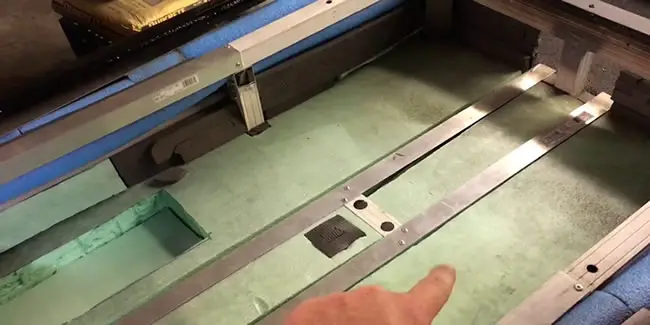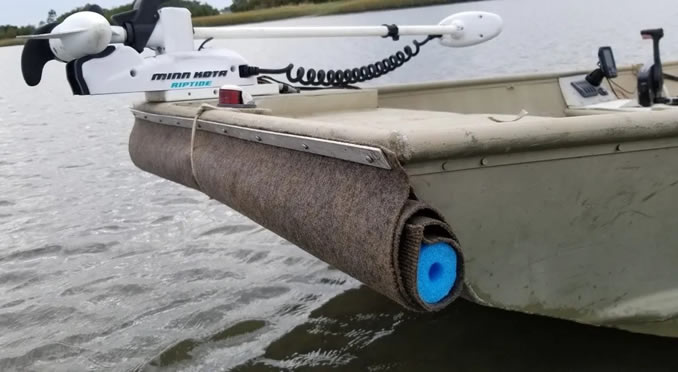Contents
How To Quiet A Boat
Some solutions include using noise and vibration dampening materials on the floor such as carpet covered styrofoam, rubber deck sheets or rubber-backed mats.
Place a silicone sheet between the hull and the outboard motor to absorb engine vibrations.
You can add a carpeted solution to the bow to reduce hull slap.
Adding some magic sound dampening materials to quiet a boat
Below are some great materials you can use to help dampen the noise of your boat.

Rubber mats work really well to dampen noise
Waterproof mats with rubber backing or rubber deck sheets can help to greatly reduce noise while providing additional comfort onboard.
Deck mats can really help to reduce noise but to be truly effective you need ones with thick rubber backings, like these.
Be aware though that both rubber deck sheeting and mats with rubber backs will add weight to your boat.
So, if you usually hit the water close to your Jon boat’s weight capacity bear in mind that rubber mats could push you over the boat’s limit.
Rubber deck sheeting, or rubber-backed mats, are great for noise reduction but will add weight to your Jon boat.
If you are concerned about the extra weight that rubber sound insulation will add to your boat and are unsure about your boat’s capacity read our Jon boat weight capacity guide.
That article shows you how to work out the weight capacity of your specific boat.
Carpeting on floor can dampen deck noise while fishing
An alternative option to using rubber is basic indoor or outdoor carpeting.
Adding carpet to your deck can go a long way to dampen noise levels in your boat.
However, it is much more effective if you add foam underneath it.
Styrofoam fill
Placing some non-expanding foam fill into your boat under the carpet adds an extra layer of noise reduction without adding any additional weight to the boat.
Simply cut sheets of styrofoam to fit the deck. Then use the foam to cover the entire floor of your boat.
Fix the foam to the floor with something like caulk making sure to leave a slot for the drain plug.

This will create a very effective noise dampening layer.
Once the foam has been laid measure and then cut the carpet so it covers the boat floor but also extends up the walls slightly.
Outdoor carpet that is fairly waterproof and can be washed with a hose is best to use if you are putting styrofoam below it.
Contrary to popular belief the foam will not make your Jon boat more buoyant though there are other good reasons to add it as we covered here.
Consider using Dri-Deck
Dri-Dek is a slightly pricier option but eliminates the need for carpet and its super easy to fit.
Dri-Deck is lighter than rubber and carpet solutions and is easy to lay and lift back up.
You can also use it under carpet or on top of it for an extra layer of noise reduction.
How to to quiet Jon boat motor noise
Trolling motors can make a hell of a racket on a Jon boat. In fact, engine noise is by far the biggest noise polluter on any boat.
However, you can greatly lessen this noise with 1 simple fix.
Placing some form of noise reducing material between the hull of the boat and the outboard motor will greatly reduce engine noise as the material will absorb much of the engine vibration.
The best material for this is silicone.
Silicone will absorb much of the engine vibrations and because it is extremely lightweight it won’t affect the overall weight of the boat at all.
Simply placing a standard silicone mat, or several silicone pads at key points, between the outboard and the hull is all you need to do to greatly reduce noise from your outboard motor.
How to quiet those oarlocks
If your Jon boat is fitted with oarlocks (yes you can row a Jon boat) then the metal fittings may be creating unnecessary noise.
Oarlocks with metal fittings can sometimes make a racket.
One way to deal with this noise pollution is to replace the metal with plastic.
Ultra-High molecular weight plastic (UHMW) can be used as it machines just as easily as wood when using ordinary woodworking tools.
And the great news is that the more you use it the harder and smoother it gets.
All you have to do is drill out the rivets holding the original oarlocks in place, and then bolt in your fabricated plastic ones instead.
UHMW Scraps are usually available from local outlets or you can buy them in sheets.
How to stop squeaking
Consider adding noise reduction tape to specific areas of your Jon boat that tend to squeak or make friction noises.
There are tapes available that incorporate UHMW technology and that are very effective for helping to reduce friction as well as noise.
These tapes are also resistant to water, oil and solvents so you won’t have to constantly re-apply new tape.
Dealing with aluminum Jon boats
Most Jon boats in the US are made from aluminum, and as most Jon boat owner know aluminum can be very noisy.
Most of the noise that is generated when using an aluminum boat comes from the outboard motor. But, as we have already taken care of that problem we will turn to the next biggest problem – hull slap!
There is a fair amount of noise generated when chop hits the bow of an aluminum boat.
Below is a very effective way to deaden that noise to make your aluminum Jon boat as quiet as a fiberglass one.
How to reduce hull slap on a Jon boat
One of the biggest problems you get with aluminum Jon boats is the noise from hull slap.
Where a fiberglass boat barely registers the noise from chop against the bow an aluminum Jon boat registers it at high decibels (at least that’s what it feels like).
The good news is that you can deck out your aluminum Jon boat so it is as quiet a deep-v fiberglass boat.

Everything you need to reduce the noise from hull slap can be be found at your local local hardware or flooring supply store and online.
Here’s what you need:
- One 0.125-inch (1/8 inch) x ¾ wide aluminum, or stainless steel, bar stock.
- This should be cut to the width of your bow or a few inches wider.
- Several #10 self-tapping stainless screws.
- Enough indoor/outdoor carpet to cover your deck.
- A foam pool noodle.
Method:
Start with a piece of either indoor or outdoor carpet that is the same width as the bow of your boat.
It should be slightly longer than the height of your bow – from the highest part of the bow to where the bow hits the surface of the water.
At one end of the carpet sew in a foam pool noodle to add buoyancy to the carpet and dampen the sound when the carpet hits the boat (as demonstrated in the video below).
You will use the bar stock to hold the other end of the carpet to the front of your Jon boat.
This is why the stock should be cut to the width of your bow.
Drill (.187) 3/16-inch holes in the bar stock.
Take your self-tapping screws and screw the bar to the bow of your boat at the hole points with the non-noodle end of the carpet kept behind the bar, i.e. screw the stock to the outer bow of the Jon boat with the non-noodle end of the carpet sandwiched between the bow and stock.
Your sound dampening device is now in place.
To use it simply throw the pool noodle end of the carpet off the bow of your boat. Water chop is then absorbed by the carpet and pool noodle.
This leaves an eddy of still water between the carpet and your hull.
You will probably want to add a strap of some kind to the front of the boat so you can roll the carpet up and secure it when you don’t need to use it.
Be aware that this will add weight to your boat.
So, again be sure your boat has the weight capacity to handle this fix.
This is what Tim Barefoot calls The Silencer.
Watch him complete this simple hull slap fix below.

